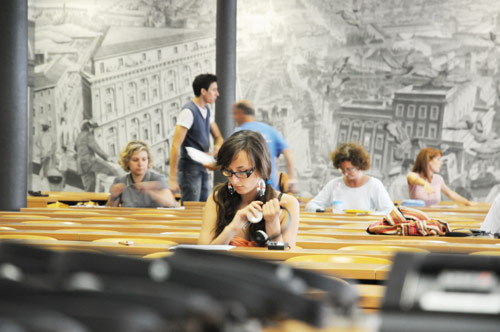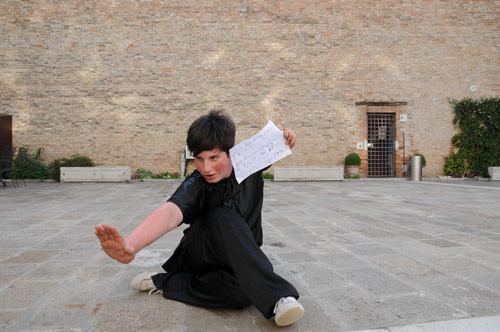
 |
|
Students attend the Chinese proficiency test (HSK) organized by Hanban at Sapienza University of Rome. |
 |
|
Alessandro Baccarin performs martial arts at Pigafetta High School in Vicenza, Italy. |
She says her elder and younger sisters also learn Chinese at the school; and adds her elder sister, who is in China with a scholarship provided by Hanban, cried on the phone because she didn't want to return to Hungary.
"The problem is not whether students want to go to China, but whether they are willing to come back. Some stay in China to further their studies or work," says Imre Hamar, director of the Confucius Institute at Eotvos Lorand University.
Hamar says to begin with about 90 percent of the school's students were Chinese, but now more than half are Hungarian.
He says that Chinese has been included as an option at middle schools.
"Middle school education is very important. Without the support of Confucius Institutes, such as teachers and textbooks, it would be impossible to teach Chinese at middle schools," he says.
Michael Schneeman, dean of education from the Goethe School in Hanover, Germany, couldn't agree more.
Four and a half years ago, his school started to offer Chinese as an optional course for students from the fifth to seventh grades, with help from the Confucius Institute.
"It's still rare to have Chinese courses in German middle schools. But we aim to promote it just like English and Latin," Schneemann says.
However, there are a lot of difficulties to overcome in some European countries.
According to Rao Qin, director of the Confucius Institute at the Ca'Foscari University of Venice, one of her biggest headaches is textbooks, which are difficult to buy in the "City of Water" due to transportation difficulties and short supply.
She recalls two years ago that many students had to use copied textbooks. It takes 10 months to get the textbooks in Italy after ordering and transportation.
"The students are thirsty for knowledge, cherish their textbooks and pass them on to others," she says.
Hanban has been striving to solve the shortage of textbooks. In 2011, it donated 2.72 million volumes of teaching materials to 110 countries and developed 150 new Chinese language-teaching materials for its annual exhibition.
Magda Abbiati, professor of Chinese language and literature at the Ca'Foscari University, has just published her two-volume Dialogue in Chinese, with the financial support of Hanban.
"English textbooks are not suitable for Italians, because we need textbooks in our mother tongue. In Italy, most Chinese teaching books are published in China, in English or French. Why not publish one in Italy?" says the Italian professor, who completed the book with the help of a Chinese teacher from the Institute.
"The book focuses on details and is suitable for Italians. For example, one can read the sequence of the strokes for each (written) character. Each lesson introduces something about Chinese culture," she says.
Yet, finding Chinese teachers who can speak Italian and Hungarian is another problem.
Qi Baihua, director of the Confucius Institute at Eotvos Lorand University, says they are now offering teaching volunteers one year's Hungarian-language training, so they can teach Chinese in Hungarian.
Qi says the volunteers earn $800 a month and they save money to visit other countries.
Still, many chose to work with the Institutes, including Qi, who earns $2,900 a month, which is actually worth less than she earns in China.
"I feel being the director - letting the locals know about China, its values and its people - is a meaningful thing," she says.
Contact the writer atxulin@chinadaily.com.cn.